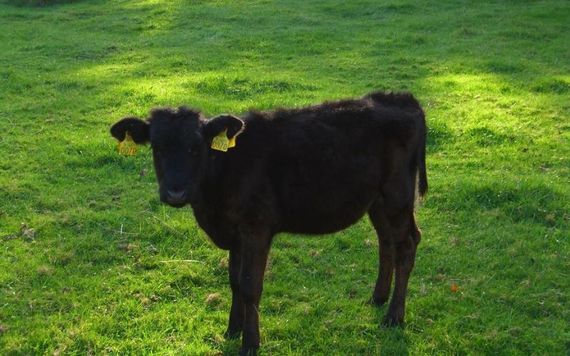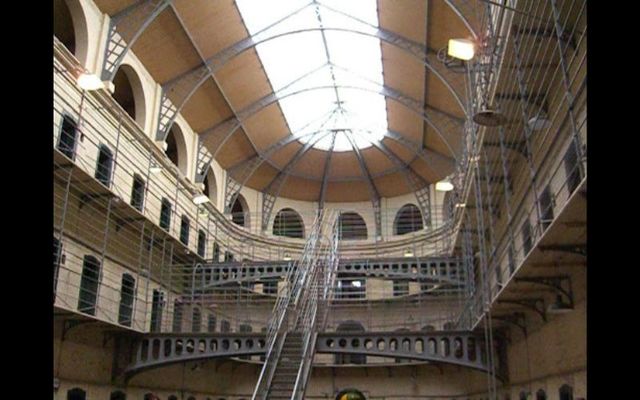Ah, the day was glorious! We drank our coffee and loaded the car for the trip to Dublin to visit Kilmainham Gaol and Glasnevin Cemetery.
We were lucky that we had seen no rain so far, but we always traveled with our coats and umbrellas, just in case. The little calf who belonged to the McKeevers, the family we rented the cottage from, was grazing close to the fence and watched us with curiosity while we drove down the graveled path.

We left the cottage around 7:30 am, heading West on the N-52, the same route we had taken on Monday on our trip to Glendalough. Through Navan, onto the N-3 South, past the Tara-Skyrne Valley and the Hill of Tara, and into the morning commute traffic. We were held up just a bit as we neared Dunshauglin, but that cleared very quickly. We followed the N-3 to where it ended around Phoenix Park, located just on the outskirts of Dublin.

We needed to find Military Road, which ran close to Inchicore Road, where the Kilmainham Gaol is situated. We missed the turn off on Military Road, driving into Dublin City itself, and had to backtrack to Inchicore Road, which happened to be a one car wide lane that allows two-way traffic. We were only running behind a few minutes, so no worries.
Tom carefully maneuvered the car through the lane, narrowly missing a truck coming the other way. As we drove up the hill towards the old prison, we watched for a parking place. Luckily, a car was loading up with passengers just across from the historic site, and we were able to park our car there, just steps away from the front door.
The building itself is made entirely of rock and mortar with the exception of the bricks used in the restoration, cold, grey, and unmoving. This prison held within its walls the best of the best of Ireland, the rebels, patriots and saints, the starving and the poor, the poets and the warriors. This prison of English design was built to house the insurgents who fought so valiantly to regain their freedom, to become once again autonomous, to be their own nation once again.

Scores of Irish people were executed here, and many hundreds, including young children and their mothers, met their untimely and wrongful deaths within the walls of this prison. It is unimaginable the suffering that the unjustifiably imprisoned Irish endured behind the stone walls. We paid our two Euros each for the entrance fee and walked through the doors. I particularly wanted to witness firsthand where many of the leaders of the 1916 Easter Rising were executed.

To me, these brave men were/are heroes, defenders of the liberty of an ancient, magical and magnificent people, who sacrificed their lives so that their families could live their own in perpetual peace. The following is part of a poem written by the great Padraig Henry Pearse, who was executed here at Kilmainham Gaol shortly after the rising. It never fails to bring tears to my eyes and heaviness to my heart:
Mise Eire
“I am Ireland. I am older than the Old Woman of Bearra. Great is my glory, I who gave birth to Cuchulain the brave. Great is my shame, my own family have sold their mother. I am Ireland, I am lonelier than the Old Woman of Bearra.” Pearse also wrote, "We know of only one definition of freedom; it is Tone's definition, it is Mitchel's definition, it is Rossa's definition. Let no man blaspheme the cause that the dead generations of Ireland served, by giving it any other name and definition other than their name and their definition."
A brave and just soul, a poet and a teacher, this man who fought alongside so many others who were murdered before, during and after the Easter Rising of 1916.


Love Irish history? Share your favorite stories with other history buffs in the IrishCentral History Facebook group.
We walked through the bookstore and into the first gallery. Here was housed a collection of memorabilia from many years before. Amongst the collection was the death mask of Robert Emmet, who was born March 4th, 1778, in Dublin, Ireland, and executed in that very same city on September 20th, 1803. His doomed and poorly organized 1803 Rising was a tragic comment to the more storied Rebellion of 1798.
When he appeared before his followers on the evening of July 23rd in full military uniform, the group of citizenry proved to be little more than a poorly organized mob. Robert Emmet was captured by the British on August 25th, 1803, and tried for his crimes on September 19th at Green Street Courthouse. He was sentenced to death for high treason, but before the sentence was imposed, was allowed to speak.
The following is only a part of his historical speech: “I have but one request to ask at my departure from this world: it is the charity of its silence. Let no man write my epitaph, for as no man who knows my motives dare now vindicate them, let not prejudice or ignorance asperse them. Let them and me rest in obscurity and peace, and my tomb remain uninscribed, and my memory in oblivion, until other times and other men can do justice to my character. When my country takes her place among the nations of the earth, then, and not till then, let my epitaph be written. I have done.”

Subsequently, he was executed by hanging on gallows opposite Saint Catherine's Church in Thomas Street in Dublin. With rope around his neck, the hangman asked if he was ready. Emmet replied “No”. The hangman asked yet again to which Robert Emmet again replied “No”. There was not a third question asked, for with one fell swoop, the floor dropped out of the scaffolding and the young hero and patriot was dead. His head was cut from his body by the hangman, Thomas Galvin, who cried out, “This is the head of a traitor, Robert Emmet”.
There are many important noted moments of Irish history exhibited in the gallery halls. There is an exhibit which houses the camera used to take “mugshots” in most recent history, one that documented the booking of the inmates into the prison, and one that described the conditions in which most of the inmates existed.

It is said that these prisoners were not given a moments rest, either being expected to say their “prayers”, shuffle one behind the other in the exercise yard, or spend hours pounding rocks to bits in the stone yard for adding yet more buildings to the already huge prison. The conditions were less than deplorable, with food at a bare minimum for these “lost” souls of the Irish, and health care a prize unknown to all but the rich.
The women and children received the same horrific accommodations. While in the visual part of the tour, we learned that the women and children were imprisoned for as little as stealing a turnip from another, or a few blades of grass from a neighbor’s yard. The children were forced to exercise just as the men and women, chin to back, toe to heel, eyes to the ground, they were tasked with considering the evil of their ways.
They were forced to do so only a few yards from where the graves of other innocent children lay. In fact, the graveyard was the “playground” for these children. The cells were filled with victims of the Great Famine, who were laid to waste and starvation, and eventually crime, through the devices of the English landlord feudal system. What horrors they must have endured whilst behind these cold and immovable walls.

The construction of the prison was brought about by the concern and fear-mongering of the English, who instilled the thought of French revolutionary ideals scattering to the shores of Ireland. It was an absolutely unreasonable fear which in the end found manifestation in the Rising of 1798. The leadership of the United Irishmen and their members in the rebellion soon filled the mucky solitary confinement and punishment cells of Kilmainham.
They were quickly followed by the rebels who participated in the revolts of 1803 led by Robert Emmet, and again 1848, and 1867. The oppressiveness of the prison was brought into sharper focus during the events of the early part of the twentieth century, after the executions in the stone breaking yard of the surviving members of the Easter Rising of 1916.
The only American involved in that rebellion, the future president of the Republic of Ireland, Eamon DeValera, was released on July 16th, 1924. Countess Constance Gore-Booth Markievicz, the only female arrested during the Rising, had her death sentence commuted to life imprisonment. She later died, on July 15th, 1927, in a public ward in Dublin, Ireland after botched attempts to remove her appendix.

The jail was soon afterward abandoned and fell into a deep state of decay. A voluntary group of local citizens took on the task of restoring the buildings in 1960, which was finally completed in the 1980s by the OPW. What we have as a result is the preservation of Europe's largest decommissioned prison from the eighteenth to nineteenth centuries. A tour of the dungeons, cells, and corridors has the ability to evoke a true sense of the prison's sadly deplorable history.

More than once, the hair actually stood up on the back of my neck. During our tour, we were taken to the upper level where the cells of the rebels of 1916 were housed. The stairs which led there were astonishing to witness, as the stone steps had been worn down by the many years of feet shuffling and trudging, up and down the cold corridor, most of them shackled together, making it impossible to escape from the gaoler.

The tour guide led us outdoors to the courtyard/stoneyard where the leaders of the 1916 Easter Rising were executed. One by one, between May 3rd and May 12th, 1916, day after day, these brave and loyal Irishmen were led, hands tightly bound behind their backs, kerchiefs placed over their eyes, to this yard. There, propped against a stone wall, they waited until a single bullet exploded deep inside their chests, their bodies crumpling to the gravel covered ground, and thus these patriots were murdered.

Out of the sixteen leaders of the Easter Rising, fourteen were executed at Kilmainham Gaol, in what is identified as the Stonebreaker’s Yard. On May 3rd, 1916, Patrick Pearse, Thomas Clarke, and Thomas MacDonagh were executed at dawn by firing squad. On May 4th, Joseph Plunkett, Edward Daly, Michael O’Hanrahan, and Willie Pearse were executed at dawn. And then on the 5th, John MacBridge was executed. Eamonn Ceannt, Michael Mallin, Sean Heuston, and Con Colbert were executed by firing squad at dawn on the 8th, and Sean Mac Diarmada and James Connolly on the 12th.
A cry went up in Ireland, unlike any heard for centuries. Those who had not supported the rebels during the insurrection certainly did now. I encourage anyone interested in the 1916 Easter Rising and Ireland's fight for freedom to research what it was about and why things happened the way they did. It will hopefully help the reader to better understand why things are as they are today on the island of Ireland.

My day may have begun as a glorious one, but it ended on a note of such intense sadness and heartache that it was all I could do to sleep that night. My visit to Kilmainham Gaol on that day in October 2006 will haunt me for the rest of my life.

*Susan Isabella Sheehan is a published author with four works to her credit, including "Ireland Journey - September 2008: A Retrospective."

This article was submitted to the IrishCentral contributors network by a member of the global Irish community. To become an IrishCentral contributor click here.




Comments